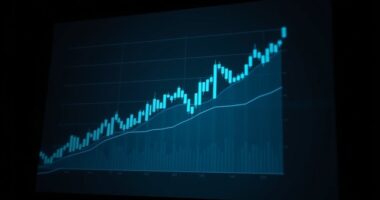Token burns and buybacks can create a perception of scarcity and signal confidence, which might temporarily boost market interest. However, their actual impact on increasing long-term value isn’t guaranteed, as it depends on project fundamentals, market conditions, and investor confidence. Simply reducing supply doesn’t ensure price growth if the project isn’t growing or gaining adoption. Want to understand the real influence of these tactics on a token’s value and what factors truly matter?
Key Takeaways
- Token burns and buybacks can reduce supply, potentially increasing scarcity and perceived value, but do not guarantee price appreciation.
- Market perception and investor sentiment heavily influence whether these tactics translate into actual value growth.
- They signal project confidence but should be part of a broader strategy; alone, they may not sustain long-term value.
- External factors like project utility, development progress, and market conditions significantly impact token value beyond supply tactics.
- Excessive or unbacked burns and buybacks may lead to skepticism, emphasizing the need for transparency and fundamental strength.

Have you ever wondered how cryptocurrency projects try to increase token value? One common strategy involves token burns and buybacks, which are designed to influence market perception and create a sense of scarcity. When a project conducts a token burn, it permanently removes a certain number of tokens from circulation, reducing the overall supply. This act often aims to signal confidence in the project’s long-term potential, suggesting that the team believes the token is undervalued or that demand will grow. By decreasing the total supply, token scarcity increases, which can lead investors to perceive the token as more valuable. The idea is rooted in economic principles: fewer tokens available means higher demand for each remaining token, potentially pushing prices upward.
Buybacks operate similarly but with a slightly different approach. Instead of burning tokens immediately, a project uses a portion of its profits or reserves to purchase tokens from the open market. These repurchased tokens are often then burned or held in reserve, reducing supply or creating buying pressure. From a market perception standpoint, buybacks can signal to investors that the project’s team believes in the token’s future value, reinforcing confidence. This action can be interpreted as a commitment to support the token’s price, which may encourage more buying activity and boost market sentiment.
However, whether token burns and buybacks genuinely increase value isn’t always straightforward. While reducing supply theoretically boosts scarcity and market perception, it doesn’t automatically guarantee price appreciation. Market conditions, investor sentiment, and broader economic factors play significant roles. If the market perceives burns or buybacks as mere marketing tricks rather than genuine efforts to improve fundamentals, the impact may be limited or short-lived. Moreover, frequent or large-scale token burns without underlying growth in project utility or adoption can lead to skepticism. Investors might question whether the project is struggling to sustain itself or relies solely on supply manipulation to boost prices.
In essence, token burns and buybacks are tools to influence perception and scarcity, which can positively impact token value if executed with transparency and backed by solid project fundamentals. They are not magic bullets but part of a broader strategy to foster confidence and signal long-term commitment. When done correctly, they can help create a healthier market environment, but it’s essential for investors to look beyond these tactics and evaluate the actual utility, development progress, and adoption of the project. Only then can they truly assess whether these measures will lead to sustained value growth. Additionally, understanding the impact of technological innovation on project value can help investors make more informed decisions about the long-term potential beyond supply-side tactics.
Frequently Asked Questions
How Do Token Burns Impact Long-Term Token Holder Incentives?
Token burns boost long-term holder incentives by creating token scarcity, which can increase demand and potentially raise the token’s value over time. When fewer tokens are available, your holdings may become more valuable, encouraging you to hold rather than sell. This process aligns your interests with the project’s success, as a reduced supply can lead to higher prices, rewarding your continued support and investment in the long run.
Can Buybacks Lead to Market Manipulation?
Imagine a puppeteer pulling strings behind a curtain—that’s how buybacks can sometimes resemble market manipulation, especially if done to inflate prices artificially. They can raise regulatory concerns, making the market less transparent and fair. While buybacks aim to boost value, if misused, they could mislead investors or distort true market sentiment, risking legal issues and loss of trust. Always stay vigilant about potential market manipulation tactics.
What Are the Hidden Costs of Implementing Token Burns and Buybacks?
Implementing token burns and buybacks can expose you to hidden costs like transaction fees, which add up quickly during large-scale operations. You also face legal risks if regulations change or if oversight bodies scrutinize your actions, potentially leading to fines or sanctions. These costs can diminish the overall benefits, so it’s essential to weigh the transaction costs and legal risks before proceeding with buybacks or burns.
Do Token Burns Always Reduce Circulating Supply Effectively?
Token burns don’t always reduce circulating supply effectively, especially when market volatility sways investor behavior. You might think of it as trying to plug a leaking boat—if governance challenges aren’t addressed, the supply might bounce back or remain unstable. While burns can help, they’re not a silver bullet. You must consider how market swings and governance issues influence the long-term impact on token scarcity and value.
How Do Burns and Buybacks Compare to Other Value-Adding Mechanisms?
Burns and buybacks can boost value more effectively than other mechanisms by positively influencing market sentiment. When you see a project reducing supply through burns or buybacks, you may feel more confident, which can drive demand. However, be aware that regulatory challenges might limit these strategies’ long-term impact. While they can create short-term excitement, sustainable growth depends on strong fundamentals and continuous innovation.
Conclusion
In the end, token burns and buybacks act like a master sculptor chiseling away at a massive block of stone—revealing the true form beneath. While they can boost perceived value and scarcity, they’re no magic wand. You have to see through the smoke and mirrors to understand that real growth depends on solid fundamentals, not just flashy tricks. Remember, in the crypto world, patience is your most powerful tool—don’t let hype blind your judgment.









